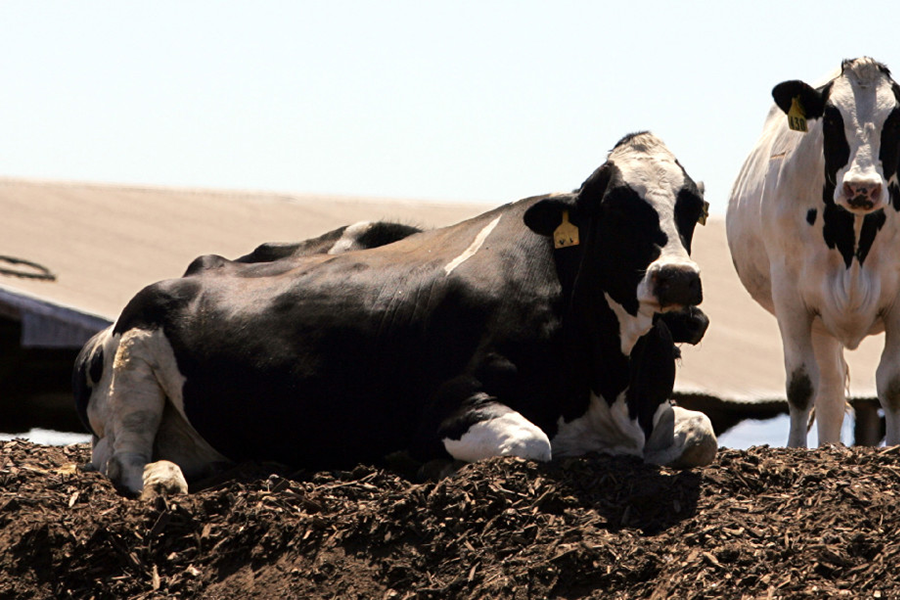Apocalypse Cow: Will California bill cut gassy livestock emissions?
Loading...
In California, the manure and flatulence coming from cows will now have something in common with the emissions coming from landfills – they'll all be regulated.
The greenhouse-gas emissions of all of the above will be regulated, after California's Democratic Gov. Jerry Brown signed legislation Monday to reduce a variety of pollutants, from methane, to hydrofluorocarbons (HFCs) used in aerosol and air conditioning refrigerants, to black carbon from diesel trucks.
California has emerged as a global leader in the fight against climate change. Earlier this month, Governor Brown signed two bills that aim to reduce state emissions by 40 percent of 1990 levels by 2030. Environmentalists hope the legislation Brown signed Monday will set another example for other states and countries to follow, specifically to regulate short-lived climate pollutants, including methane, which is dozens of times more potent than carbon dioxide.
The new California law targets these short-lived pollutants, which disproportionately contribute to global warming. Although they exist in the atmosphere for only a short period of time, they have heat-trapping effects. Environmentalists hope that by reducing short-lived pollutants, that would buy time to develop new and more affordable technology to reduce carbon emissions.
Livestock contribute about 14.5 percent of global greenhouse-gas emissions, according to the Food and Agriculture Organization of the United Nations. Methane accounts for about 44 percent of these emissions, of which cows contribute the lion’s share.
Cows release methane when they belch or let it out their back ends.
In California, dairy farmers will be required to reduce methane emissions from manure to 40 percent below their 2013 levels by 2030. They will receive $50 million from the fees the state collects from polluters through its cap-and-trade program. The funding will go toward buying methane digesters, which generate energy from the methane in manure. The energy will be sold to electrical utilities.
The law also allows the Air Resources Board to regulate cow flatulence if a practical technology exists to reduce it.
California dairy is big business. The state produces 20 percent of the nation’s milk. It is also home to 5.15 million cows, nearly 6 percent of the country’s cattle population, according to Drovers CattleNetwork. Texas has the most cattle of any state at 11.8 million.
California Republicans and business advocates said the new law will hurt agricultural business, even with the funding.
The law "represents a direct assault on California's dairy industry and will hurt manufacturing by creating an arbitrary limit on natural gases which dissipate quickly," said Tom Scott, California director for the National Federation of Independent Business, a small-business advocacy group.
The governor has hoped the state's aggressive climate regulations will serve as an example for other states and the country.
"The real source of climate action has to come from states and provinces," he told the Climate Change Summit of the Americas in 2015. "This is a call to arms. We're going to build up such a drumbeat that our national counterparts – they're going to listen."
If California is successful in reducing methane emissions from cows, it could inspire other nations to follow suit. The United States is behind India as the largest dairy producer in the world.
But a July 2014 study by Gidon Eshel, an environmental physics professor at Bard College in New York, found that above dairy production, beef production is the most disastrous for the environment.
“Compared with the other animal proteins, beef produces five times more heat-trapping gases per calorie, puts out six times as much water-polluting nitrogen, takes 11 times more water for irrigation and uses 28 times the land,” wrote Seth Borenstein for the Associated Press, about the study. “Because they are bigger and take longer to put on weight for meat, cows eat more food over their lifetimes than other animals raised for protein.”
The new California laws also call for reductions in carbon emissions from diesel trucks and other sources by 50 percent.
In a news conference on Monday, Brown compared curbing climate change to building Noah’s Ark.
"When Noah wanted to build his ark, most of the people laughed at him," said Brown during. "We've got to build our ark too, by stopping climate change, by stopping dangerous pollutants."
This report contains material from the Associated Press and Reuters.







